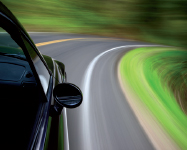Printed Page 807
CHAPTER 11 PROJECTHow to Design a Safe Road

807
When a car moves around a corner, we often feel ourselves being pulled outward. This “pull” is due to inertia, the tendency to move along straight-line paths. Without some sort of centripetal (center-seeking) force, a passenger would move in a tangent line to the circle while the car turned underneath. It is the frictional force exerted by the road on the tires that keeps the car from sliding off the road, and it is a combination of forces between a passenger and the seat/seatbelt which pushes the passenger into a circular path.
In this project we examine the forces acting on a moving vehicle under three different scenarios involving exiting from one road to another, and a fourth involving the forces affecting a vehicle during a high speed turn.
They are:
- Exiting from one road to another road that are perpendicular along a flat circular ramp.
- Exiting from one road to another road that are perpendicular along a flat circular ramp that is angled (banked) at an angle to the horizontal.
- Exiting from one road to another road that is approximately 28 ft above the first along an inclined, banked ramp.
- Traveling along a rural highway as the road curves.
Suppose a car weighing 3800 lb is traveling at a constant speed of 30 mi/h.
- (a) What is the speed of the car in ft/s?
- (b) What is the mass m of the car? (Hint: weight w = mg, where g = 32 ft/s2.)
Suppose the car exits from one road to another on a flat circular ramp of radius 100 ft given by the vector equation r=r(t)=100sin(ωt)i+100cos(ωt)j0≤t≤π2ω
where ω is the angular speed of the car.
- Graph r=r(t). Explain how the vector function r=r(t) models a circular ramp connecting two roads that intersect at a right angle.
- (a) Find ω.
- (b) Find the velocity vector v=v(t).
- (c) Find the acceleration vector a=a(t).
What is the magnitude of the frictional force required to keep the car from sliding on the ramp?
Now suppose the circular exit ramp leading from one road to the other is banked. That is, the ramp is pitched at an angle θ to the horizontal. This banking helps push the car into a circular path, much as friction did in the scenario where the road was flat. We wish to find the angle θ so that the car will travel in a circular path even on a very slick (frictionless) road. Since, in practice, the road will not be frictionless, the angle of banking is often less than θ.
We wish to find θ so that there is no lateral centripetal force. In doing so, we ignore the frictional force exerted on the tires so that, in practice, the angle used could be smaller than θ.
Suppose the same 3800 lb car, traveling at a constant speed of 30 mi/h, exits from one road to another on a banked, circular ramp of radius 100 ft, (Equation (1)), that is pitched at an angle θ,0<θ<π2, to the horizontal.
- (a) If n is the normal force vector exerted by the car as it moves along the ramp, show that the weight of the car is ncosθ and the centripetal force is F=nsinθ. (Hint: Draw a force diagram.)
- (b) Find the magnitude of F. [Hint: Use F=ma and the results found in Problems 4 and 5.]
- (c) Use the results of (a) and (b) to find sinθ and cosθ.
- (d) Find tanθ, and solve for θ.
808
Suppose a road with an E-W direction passes under a second road with a N-S direction, and the N-S road is 28.27 ft higher than the E-W road. You are driving East and want to head North. An inclined, banked exit ramp from the lower road to the higher road can be modeled by the vector equation r=r(t)=100sin(ωt)i+100cos(ωt)j+6ωtk0≤t≤3π2ω
Graph r=r(t) and explain how the graph satisfies the conditions required of the ramp.
Find the angle θ to bank the exit ramp so that a 3800 lb car travelling at a constant speed of 30 mi/h will travel in a circular path of constant radius. Explain your answer mathematically.
The discussion above can also be used to answer the following questions.
A rural highway has a posted speed of 65 mi/h. At a certain point the highway curves and follows a flat circular path of radius 1000 ft given by r=r(t)=1000sin(ωt)i+1000cos(ωt)j
Suppose the road is banked at an angle of 10° %TCIMACRO{\U{b0}}% %BeginExpansion {{}^\circ}% %EndExpansion . What speed limit should be set so that a car weighing 3800 lb would travel in a circular path of constant radius even if the road became slick? Express your answer in mi/h.
Repeat Problem 8 for a vehicle weighing 10,000 lb. Explain why the answer makes sense.
Narrowing the width of a lane from 12 ft to 11 ft increases the likelihood of an accident at approximately the same rate as decreasing the banking angle by 1° %TCIMACRO{\U{b0}}% %BeginExpansion {{}^\circ}% %EndExpansion . Repeat Problem 8 if the banking angle is 9° %TCIMACRO{\U{b0}}% %BeginExpansion {{}^\circ}% %EndExpansion. Explain how this might influence the choice of a banking angle vs. an increase in lane width.
Describe the role of the curvature of the road used for an exit ramp. Assume the speed of the vehicle is constant.
Source: “Prediction of the Expected Safety Performance of Rural Two-Lane Highways” http://www.fhwa.dot.gov/publications/research/safety/99207/99207.pdf